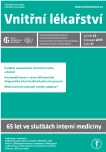-
Medical journals
- Career
Pancytopenia, panhypopituitarism and liver cirrhosis: analysis of a difficult clinical case
Authors: Pavel Polák 1,2; Jan Kamelander 1; Jana Michalcová 1,2; Jiřina Zavřelová 1,3; Libor Červinek 4; Tomáš Rohan 5; Zuzana Pazdičová 5; Václav Odstrčilík 6; Miroslav Penka 1,2,3
Authors‘ workplace: Oddělení klinické hematologie FN Brno, pracoviště Bohunice 1; LF MU, Brno 2; Katedra laboratorních metod LF MU, Brno 3; Interní hematologická a onkologická klinika LF MU a FN Brno, pracoviště Bohunice 4; Klinika radiologie a nukleární medicíny LF MU a FN Brno, pracoviště Bohunice 5; Klinika ústní, čelistní a obličejové chirurgie LF MU a FN Brno, pracoviště Bohunice 6
Published in: Vnitř Lék 2019; 65(11): 715-720
Category: Case reports
Overview
Panhypopituitarism following craniopharyngioma resection has systemic impact with potential influence on physiological hematopoiesis. There is a growing body of evidence of liver fibrosis/cirrhosis risk development due to altered metabolism and lipid accumulation. The authors present a case report of a woman with a history of craniopharyngioma resection followed by aggravating pancytopenia with suspected indolent lymphoproliferative disorder and possible acquired bone marrow aplasia syndrome due to paroxysmal nocturnal hemoglobinuria. A complex hemostasis disorder with deficiency of multiple coagulation factors (FXII, FXI, FX, FIX, FVII, FX, FV, FXIII, antitrombin, protein C, protein S) was accidentally detected. Despite normal sonographic liver imaging, all possible causes of chronic liver disease were systematically excluded (viral hepatitis, hemochromatosis, Wilson´s disease, α-1-antitrypsin deficiency); anti-LKM-1 and anti-ENA antibodies were detected. Finally, the magnetic resonance imaging confirmed image of liver cirrhosis – with signs of portal hypertension.
Keywords:
coagulopathy – liver cirrhosis – pancytopenia – panhypopituitarism
Sources
- Kim DY, Kim JH, Park YJ et al. Case of complete recovery of pancytopenia after treatment of hypopituitarism. Ann Hematol 2004; 83(5): 309–312. Dostupné z DOI: <http://dx.doi.org/10.1007/s00277–003–0800–4>.
- Holmes GI, Shepherd P, Walker JD. Panhypopituitarism secondary to a macroprolactinoma manifesting with pancytopenia: case report and literature review. Endocr Pract 2011; 17(2): e32-e36. Dostupné z DOI: <http://dx.doi.org/10.4158/EP10298.CR>.
- Lang D, Mead JS, Sykes DB. Hormones and the bone marrow: panhypopituitarism and pancytopenia in a man with a pituitary adenoma. J Gen Intern Med 2015; 30(5): 692–696. Dostupné z DOI: <http://dx.doi.org/10.1007/s11606–014–3161-x>.
- Hüning I, Gillessen-Kaesbach G. Fibrodysplasia ossificans progressiva: clinical course, genetic mutations and genotype-phenotype correlation. Mol Syndromol 2014; 5(5): 201–211. Dostupné z DOI: <http://dx.doi.org/10.1159/000365770>.
- Licata MJ, Janakiram M, Tan S et al. Diagnostic challenges of adult T-cell leukemia/lymphoma in North America – a clinical, histological, and immunophenotypic correlation with a workflow proposal. Leuk Lymphoma 2018; 59(5): 1188–1194. Dostupné z DOI: <http://dx.doi.org/10.1080/10428194.2017.1365862>.
- Sahin F, Ozkan MC, Mete NG et al. Multidisciplinary clinical management of paroxysmal nocturnal hemoglobinuria. Am J Blood Res 2015; 5(1): 1–9.
- Boyer T, Grardel N, Copin MC et al. Paroxysmal nocturnal hemoglobinuria (PNH) and T cell large granular lymphocyte (LGL) leukemia – an unusual association: another cause of cytopenia in PNH. Ann Hematol 2015; 94(10): 1759–1760. Dostupné z DOI: <http://dx.doi.org/10.1007/s00277–015–2439–3>.
- Čermák J. Aplastická anémie. Vnitř Lék 2018; 64(5): 501–507.
- Orlandi E, Boselli P, Covezzi R et al. Reversal of bone marrow hypoplasia in anorexia nervosa: case report. Int J Eat Disord 2000; 27(4): 480–482.
- Greer JP, Arber DA, Blader B et al. Wintrobe´s clinical hematology. 13th ed. Lippincott Williams and Wilkins: Philadelphia, USA 2014. ISBN 978–1451172683.
- Maier KP. Hepatitis – Hepatitisfolgen. 6th ed. Hans Huber: Bern 2010. ISBN 978–3456846743
- Alfani R, Vassallo E, De Anseris AG et al. Pediatric fatty liver and obesity: not always just a matter of non-alcoholic fatty liver disease. Children (Basel) 2018; 5(12). pii: E169. Dostupné z DOI: <http://dx.doi.org/10.3390/children5120169>.
- Jung SY, Lee YJ, Lee HJ et al. Nonalcoholic fatty liver disease in long-term survivors of childhood-onset craniopharyngioma. Ann Pediatr Endocrinol Metab 2017; 22(3): 189–196. Dostupné z DOI: <http://dx.doi.org/10.6065/apem.2017.22.3.189>.
- Liberal R, Grant CR, Longhi MS et al. Diagnostic criteria of autoimmune hepatitis. Autoimmun Rev 2014; 13(4–5): 435–440. Dostupné z DOI: <http://dx.doi.org/10.1016/j.autrev.2013.11.009>.
Labels
Diabetology Endocrinology Internal medicine
Article was published inInternal Medicine

2019 Issue 11-
All articles in this issue
- Functional gastrointestinal disorders and pain
- May warfarin prevent cancer?
- Immunodeficiency in the differential diagnosis of interstitial lung diseases
- Why rapid achievement of goal blood pressure is important in the treatment of arterial hypertension
- Interferon-alpha in the treatment of myeloproliferative diseases
- Pancytopenia, panhypopituitarism and liver cirrhosis: analysis of a difficult clinical case
- Vitamin D deficiency and its health effects
-
Sekundární prevence ischemické choroby srdeční a chorob periferních tepen kombinací antiagregační a antikoagulační léčby
Odborné stanovisko České kardiologické společnosti, České internistické společnosti ČLS J.E. Purkyně a České angiologické společnosti ČLS J.E. Purkyně k výsledkům studie COMPASS - Odešel profesor Ivo Dvořák
- Primář Jiří Spáčil oslavil 80. narozeniny
- Profesor Jan Petrášek slaví devadesáté narozeniny
- The myths and facts about arterial hypertension: do we really know everything about arterial hypertension?
- Spinal epidural abscess – a rare complication of Crohn´s disease: case report
- Internal Medicine
- Journal archive
- Current issue
- Online only
- About the journal
Most read in this issue- Functional gastrointestinal disorders and pain
- Interferon-alpha in the treatment of myeloproliferative diseases
- Vitamin D deficiency and its health effects
- Immunodeficiency in the differential diagnosis of interstitial lung diseases
Login#ADS_BOTTOM_SCRIPTS#Forgotten passwordEnter the email address that you registered with. We will send you instructions on how to set a new password.
- Career

